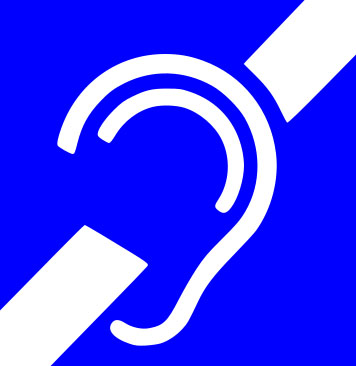Hearing impairment: Difference between revisions
Jump to navigation
Jump to search
No edit summary |
|||
| (24 intermediate revisions by 4 users not shown) | |||
| Line 1: | Line 1: | ||
__NOTOC__ | |||
{{Infobox_Disease | | {{Infobox_Disease | | ||
Name = {{PAGENAME}} | | Name = {{PAGENAME}} | | ||
Image = International Symbol for Deafness.svg | | Image = International Symbol for Deafness.svg | | ||
Caption = The International Symbol for Deafness | | Caption = The International Symbol for Deafness | | ||
}} | }} | ||
'''For patient information click [[{{PAGENAME}} (patient information)|here]]''' | |||
{{Hearing impairment}} | {{Hearing impairment}} | ||
{{SK}} Hearing loss | {{SK}} Hearing impairment, deafness, decreased hearing; loss of hearing | ||
== | ==[[Hearing impairment overview|Overview]]== | ||
==[[Hearing impairment historical perspective|Historical Perspective]]== | |||
== | ==[[Hearing impairment classification|Classification]]== | ||
== | ==[[Hearing impairment pathophysiology|Pathophysiology]]== | ||
== | ==[[Hearing impairment causes|Causes]]== | ||
==[[Hearing impairment differential diagnosis|Differentiating Hearing Impairment from other Diseases]]== | |||
==[[Hearing impairment epidemiology and demographics|Epidemiology and Demographics]]== | |||
==[[Hearing impairment risk factors|Risk Factors]]== | |||
==[[Hearing impairment screening|Screening]]== | |||
==[[Hearing impairment natural history, complications and prognosis|Natural History, Complications and Prognosis]]== | |||
==[[Hearing impairment diagnosis|Diagnosis]]== | |||
[[Hearing impairment history and symptoms|History and Symptoms]] | [[Hearing impairment physical examination|Physical Examination]] | [[Hearing impairment laboratory findings|Laboratory Findings]] | [[Hearing impairment CT|CT]] | [[Hearing impairment MRI|MRI]] | [[Hearing impairment other imaging findings|Other Imaging Findings]] | [[Hearing impairment other diagnostic studies|Other Diagnostic Studies]] | |||
==Treatment== | |||
[[Hearing impairment medical therapy|Medical Therapy]] | [[Hearing impairment surgery|Surgery]] | [[Hearing impairment primary prevention|Primary Prevention]] | [[Hearing impairment secondary prevention|Secondary Prevention]] | [[Hearing impairment cost-effectiveness of therapy|Cost-Effectiveness of Therapy]] | [[Hearing impairment social impact|Social Impact]] | [[Hearing impairment future or investigational therapies|Future or Investigational Therapies]] | |||
==Case Studies== | |||
:[[Hearing impairment case study one|Case #1]] | |||
==Related Chapters== | |||
*[[Audism]], discrimination against Deaf and hard-of-hearing people | *[[Audism]], discrimination against Deaf and hard-of-hearing people | ||
*[[Auditory brainstem response]] (ABR) test | *[[Auditory brainstem response]] (ABR) test | ||
*[[Deaf culture]] | *[[Deaf culture]] | ||
*[[Hearing | *[[Hearing impairment with craniofacial syndromes]] | ||
*[[King-Kopetzky syndrome]] | *[[King-Kopetzky syndrome]] | ||
*[[Models of deafness]] for a comparison of the medical, disability and cultural models of deafness. | *[[Models of deafness]] for a comparison of the medical, disability and cultural models of deafness. | ||
*[[Mondini Dysplasia]] | *[[Mondini Dysplasia]] | ||
*[[Noise induced | *[[Noise induced Hearing impairment]] | ||
*[[Noise pollution]] | *[[Noise pollution]] | ||
*[[Post-lingual hearing impairment]] | *[[Post-lingual hearing impairment]] | ||
*[[Pre-lingual deafness]] | *[[Pre-lingual deafness]] | ||
*[[Tinnitus]] | *[[Tinnitus]] | ||
*[[Unilateral | *[[Unilateral Hearing impairment]] | ||
==External | ==External Links== | ||
*[http://www.who.int/mediacentre/factsheets/fs300/en/ World Health Organization fact sheet on deafness and hearing impairment] | *[http://www.who.int/mediacentre/factsheets/fs300/en/ World Health Organization fact sheet on deafness and hearing impairment] | ||
*[http://www.nad.org/ National Association of the Deaf.] The NAD protects deaf and hard of hearing civil rights. | *[http://www.nad.org/ National Association of the Deaf.] The NAD protects deaf and hard of hearing civil rights. | ||
{{Geriatrics}} | {{Geriatrics}} | ||
{{WH}} | |||
{{WS}} | |||
[[tr:Duyma kaybı]] | |||
[[es:Sordera]] | |||
[[fr:Surdité]] | |||
[[ja:聴覚障害者]] | |||
[[pt:Surdez]] | |||
[[ru:Нарушение слуха]] | |||
[[Category:Geriatrics]] | [[Category:Geriatrics]] | ||
| Line 69: | Line 75: | ||
[[Category:Otolaryngology]] | [[Category:Otolaryngology]] | ||
[[Category:Noise pollution]] | [[Category:Noise pollution]] | ||
[[Category:Symptoms]] | |||
[[Category:Signs and symptoms]] | [[Category:Signs and symptoms]] | ||
Latest revision as of 05:09, 26 April 2021
| Hearing impairment | |
 | |
|---|---|
| The International Symbol for Deafness |
For patient information click here
|
Hearing impairment Microchapters |
|
Diagnosis |
|---|
|
Treatment |
|
Case Studies |
|
Hearing impairment On the Web |
|
American Roentgen Ray Society Images of Hearing impairment |
Synonyms and keywords: Hearing impairment, deafness, decreased hearing; loss of hearing
Overview
Historical Perspective
Classification
Pathophysiology
Causes
Differentiating Hearing Impairment from other Diseases
Epidemiology and Demographics
Risk Factors
Screening
Natural History, Complications and Prognosis
Diagnosis
History and Symptoms | Physical Examination | Laboratory Findings | CT | MRI | Other Imaging Findings | Other Diagnostic Studies
Treatment
Medical Therapy | Surgery | Primary Prevention | Secondary Prevention | Cost-Effectiveness of Therapy | Social Impact | Future or Investigational Therapies
Case Studies
Related Chapters
- Audism, discrimination against Deaf and hard-of-hearing people
- Auditory brainstem response (ABR) test
- Deaf culture
- Hearing impairment with craniofacial syndromes
- King-Kopetzky syndrome
- Models of deafness for a comparison of the medical, disability and cultural models of deafness.
- Mondini Dysplasia
- Noise induced Hearing impairment
- Noise pollution
- Post-lingual hearing impairment
- Pre-lingual deafness
- Tinnitus
- Unilateral Hearing impairment
External Links
- World Health Organization fact sheet on deafness and hearing impairment
- National Association of the Deaf. The NAD protects deaf and hard of hearing civil rights.